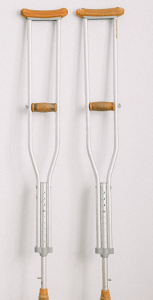What is an ankle sprain
An ankle sprain is an injury to one or more ligaments in the ankle, usually on the outside which is known as the lateral side. Ligaments are bands of tissue that connect one bone to another and hold joints together. In the ankle joint, ligaments hold the foot bones in between the ends of the leg bones.
An ankle sprain often occurs when the foot suddenly twists or rolls, forcing the ankle joint out of its normal position. This causes one or more ligaments around the ankle to stretch or tear.
Ankle sprains can happen to anyone at any age. Participating in sports, walking on uneven surfaces, or even wearing inappropriate footwear like high heels can all cause this type of injury.
Swelling or bruising can occur as a result of these tears. Tendons, cartilage, and blood vessels might also be damaged due to the sprain.
Types of sprained ankle
The severity of an ankle sprain depends on whether the ligament is stretched, partially torn or completely torn, as well as on the number of ligaments involved.
Of the lateral (outside) ankle ligaments, the most common sprain is the anterior talofibular ligament (ATFL) which is slightly in front of your ankle. The other ligaments that may be affected are the calcaneo-fibular (CFL) and posterior talofibular ligaments (PTFL). These are below and slightly behind your ankle, and are less likely to be sprained.
The medial (inside) ankle ligaments are very strong and much less likely to be injured. Known as the deltoid ligament complex the posterior tibiotalar (PTTL), tibiocalcaneal (TCL), tibionavicular (TNL) and anterior tibiotalar ligaments (ATTL) need a severe and forceful “rolling in” of the foot to cause a sprain.
A High Ankle Sprain occurs when the transverse ligaments holding the two leg bones (tibia and fibula) together are injured. This is the least common type of ankle sprain.
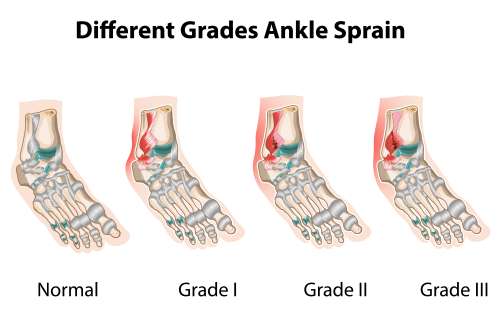
First aid for ankle sprains
The principles of ankle sprain treatment are easily summed up with the acronym PRICE. Some people prefer the acronym POLICE where Optimal Loading is substituted for Rest. This addresses the confusion around the meaning of Rest which some people interpret as meaning complete immobilisation.
Protection
Rest or Optimal Loading
Ice
Compression
Elevation
Protection
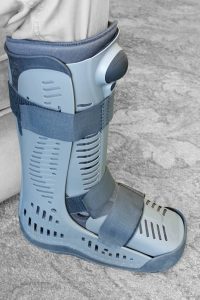
This is intended to prevent further injury and might simply mean stopping your activity. It may also involve the use of crutches or a cam walker in the early stages to prevent movement which would further damage the injured ligaments.
The “4 step test” will guide you as to the type of protection needed. If you cannot take 4 steps on the injured foot then you need professional help and investigation, plus protection with crutches and a cam walker device.
Rest / Optimal Loading
Depending on the severity of the sprain, this might
mean using crutches for partial weight bearing, or simply limiting your activity to that which is not painful, but still beneficial to healing.
Ice
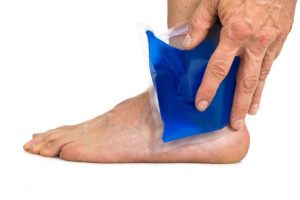
In the first three days use an ice pack wrapped in a damp towel on the area every 3 hours for no more than 20 minutes. Take care if you have diabetes or circulation problems in your legs, that you do not cause a freeze burn or tissue damage.
Compression
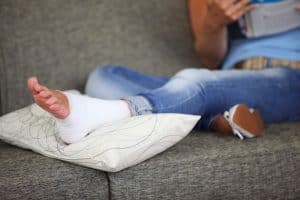
Applying an elastic bandage or mild compression garment from the toes to above the ankle will help in managing swelling. Care must be taken to ensure that circulation is not restricted. The bandage can be loosened if it feels too tight.
Elevation
When seated elevate your foot and leg so that it is not hanging down below your hip. This will assist in reducing swelling, and allow blood flow in the area.
Other advice after this type of injury is to avoid HARM
Heat Alcohol Re Injury Massage
Heat alcohol and massage will all affect blood flow in the area, and may interfere with natural healing processes. Re Injury refers back to protection and rest or optimal loading. Doing too much too soon may not be ideal.
Pain Management
An over the counter anti-inflammatory medicine like ibuprofen may help to reduce swelling and inflammation. Be careful that you avoid Re Injury and continue with Rest /Optimal Loading after using this type of medicine. You might feel better, but the ligament still needs to heal.
Recovery from Sprained Ankle
You should start with gentle non-weightbearing exercises, circling your ankle and “writing your name” with your foot. (imagine your big toe is a pencil, and move your ankle to write your name in mid air).
Sitting , use a towel to pull your foot towards you. This will help to stretch the tendons and maintain joint mobility. You may also push your foot back against the towel to work your calf muscles.
Once you are able, gentle weightbearing exercises and walking will help maintain strength. Try balancing on the injured foot for at least 10 seconds.
You should be able to walk normally before you attempt running, and should avoid high impact activities for at least four weeks. Using an ankle brace may assist you to get back to normal activities sooner.

The ankle brace should prevent the ankle from rolling in the direction that caused the sprain.

